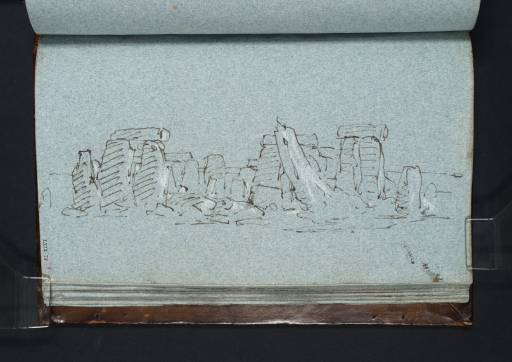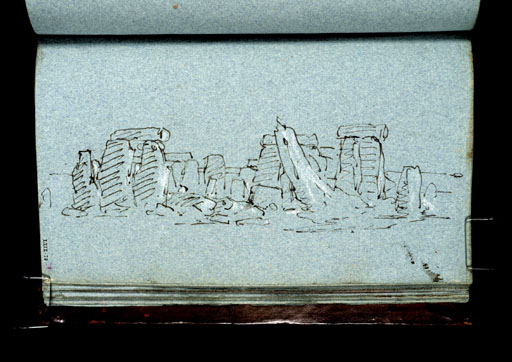Joseph Mallord William Turner Stonehenge ?1799
Image 1 of 2
Joseph Mallord William Turner,
Stonehenge
?1799
Joseph Mallord William Turner 1775–1851
Folio 79 Recto:
Stonehenge ?1799
D04090
Turner Bequest LXIX 79
Turner Bequest LXIX 79
Ink and white chalk on blue laid paper, 135 x 210 mm
Watermark: Strasburg lily (trimmed)
Inscribed by John Ruskin in red ink ‘79’ bottom left, descending vertically
Stamped in black ‘LXIX-79’ bottom left, descending vertically
Watermark: Strasburg lily (trimmed)
Inscribed by John Ruskin in red ink ‘79’ bottom left, descending vertically
Stamped in black ‘LXIX-79’ bottom left, descending vertically
Accepted by the nation as part of the Turner Bequest 1856
References
1909
A.J. Finberg, A Complete Inventory of the Drawings of the Turner Bequest, London 1909, vol.I, p.172 LXIX 79 (as ‘Stonehenge’ c.1800–2).
This study was made with the page turned horizontally; see folio 80 verso (D04092) for a view of Stonehenge from the opposite side. A diagrammatic sketch of the site is on folio 42 recto (D04046). These studies of Stonehenge were perhaps made while Turner was travelling to or from Fonthill in Wiltshire while working on William Beckford’s commission for a set of views of his ‘Gothick Abbey’, then in course of construction. The five watercolours were shown at the Royal Academy in 1800 (private collection; Art Gallery of Ontario, Toronto; Montréal Museum of Fine Arts; National Galleries of Scotland, Edinburgh; Whitworth Art Gallery, Manchester).1
While it was natural enough for a landscape painter to wish to record the appearance of the unique megalithic monument, Turner may have had it in mind to include such a henge in one of the historical pictures he was then contemplating. James Barry (1741–1806) had introduced one into the background of his King Lear Weeping over the Dead Body of Cordelia (Tate T00556), painted for Boydell’s Shakespeare Gallery in 1786–8,2 and Thomas Jones (1742–1803) included a henge in his 1774 painting of The Bard (National Museum Wales, Cardiff).3 This supplied a direct precedent for Turner’s own treatment of the subject of the extermination of the Bards in the pair of large watercolours he planned at this time; see the Introduction to this sketchbook, and under folio 18 recto (D04012).
It should be noted that the style of these two drawings of Stonehenge is similar to that of figure studies on folios 20 recto–22 recto (D04014–D04016), which may indicate that they were executed at the same time as part of the same train of thought.
Andrew Wilton
May 2013
How to cite
Andrew Wilton, ‘Stonehenge ?1799 by Joseph Mallord William Turner’, catalogue entry, May 2013, in David Blayney Brown (ed.), J.M.W. Turner: Sketchbooks, Drawings and Watercolours, Tate Research Publication, April 2016, https://www


